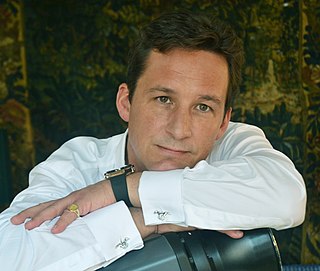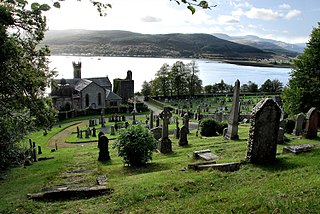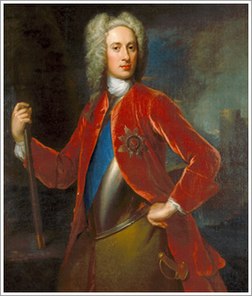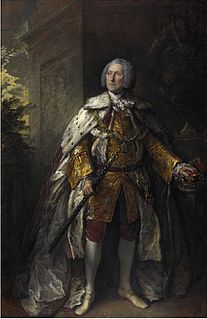
Clan Campbell is a Highland Scottish clan. Historically one of the largest and most powerful of the Highland clans, their lands were in Argyll and the chief of the clan became the Earl and later Duke of Argyll.

Elizabeth Hamilton Campbell, Duchess of Hamilton, Duchess of Argyll & 1st Baroness Hamilton of Hameldon was a celebrated Irish belle, lady-in-waiting and society hostess.

The Duchess of Argyll is typically the wife of the Duke of Argyll, an extant title in the Peerage of the United Kingdom created in 1892. The Duke is also Duke of Argyll in the Peerage of Scotland, which was originally created in the 1701.

Duke of Argyll is a title, created in the Peerage of Scotland in 1701 and in the Peerage of the United Kingdom in 1892. The Earls, Marquesses, and Dukes of Argyll were for several centuries among the most powerful noble families in Scotland. As such, they played a major role in Scottish history throughout the 16th, 17th, and 18th centuries. The Duke of Argyll also holds the hereditary titles of chief of Clan Campbell and Master of the Household of Scotland.

Earl Cawdor, of Castlemartin in the County of Pembroke, is a title in the Peerage of the United Kingdom. It was created in 1827 for John Campbell, 2nd Baron Cawdor.

Field Marshal John Campbell, 5th Duke of Argyll, styled Marquess of Lorne from 1761 to 1770, was a Scottish soldier and nobleman. After serving as a junior officer in Flanders during the War of the Austrian Succession, he was given command of a regiment and was redeployed to Scotland where he opposed the Jacobites at Loch Fyne at an early stage of the Jacobite Rebellion and went on to fight against them at the Battle of Falkirk Muir and then at the Battle of Culloden. He later became adjutant-general in Ireland and spent some 20 years as a Member of Parliament before retiring to Inveraray Castle.

George John Douglas Campbell, 8th Duke of Argyll,, styled Marquess of Lorne until 1847, was a Scottish peer and Liberal politician as well as a writer on science, religion, and the politics of the 19th century.

Torquhil Ian Campbell, 13th and 6th Duke of Argyll, styled as Earl of Campbell before 1973 and as Marquess of Lorne between 1973 and 2001, is a Scottish peer.

Baron Hamilton of Hameldon, of Hambledon in the County of Leicester, is a title in the Peerage of Great Britain, held by the Duke of Hamilton from 1790 to 1799 and by the Duke of Argyll since 1799.
This is a list of people who served as Lord Lieutenant of Argyllshire. The office was created on 6 May 1794 and replaced by the Lord Lieutenant of Argyll and Bute in 1975.

Lord Frederick Campbell was a Scottish nobleman and politician. He was lord clerk register of Scotland, 1768-1816; Member of Parliament (M.P.) for Glasgow Burghs (1761–1780) and for Argyllshire (1780–1799).

George William Campbell, 6th Duke of Argyll GCH, PC, styled Earl of Campbell from 1768 to 1770 and Marquess of Lorne from 1770 to 1806, was a Scottish Whig politician and nobleman.
Events from the year 1693 in the Kingdom of Scotland.
The Lord of Kintyre is a title in the Peerage of Scotland for Kintyre, which was created in 1626.

Kilmun Parish Church and Argyll Mausoleum in Kilmun on the Cowal Peninsula, Scotland, consists of St Munn's Church, as well as the adjacent mausoleum of the Dukes of Argyll and a historically significant churchyard. The complex is located on the summit of a slight knoll about ten metres from the shoreline of the Holy Loch. The existing church dates from 1841 and occupies the site of an older, medieval church. A partly ruined tower from the medieval period still stands to the west of the present building.
General Hugh Warburton was an officer of the British Army.
Colonel John Campbell, of Shawfield and Islay was a Scottish soldier in the British Army, and briefly a politician. After his early death, his widow Lady Charlotte Bury achieved fame as a diarist and novelist.













